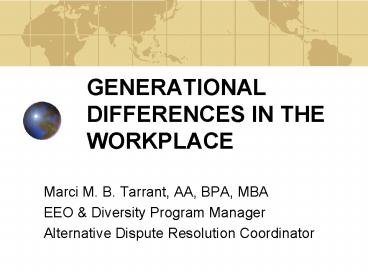GENERATIONAL DIFFERENCES IN THE WORKPLACE - PowerPoint PPT Presentation
1 / 20
Title:
GENERATIONAL DIFFERENCES IN THE WORKPLACE
Description:
To heighten awareness and understanding of the generalized differences among ... conflicts, stress, discomfort, frustration, and miscommunication. ... – PowerPoint PPT presentation
Number of Views:160
Avg rating:3.0/5.0
Title: GENERATIONAL DIFFERENCES IN THE WORKPLACE
1
GENERATIONAL DIFFERENCES IN THE WORKPLACE
- Marci M. B. Tarrant, AA, BPA, MBA
- EEO Diversity Program Manager
- Alternative Dispute Resolution Coordinator
2
OBJECTIVE
- To heighten awareness and understanding of the
generalized differences among generations, in
order to decrease misunderstandings, conflicts,
stress, discomfort, frustration, and
miscommunication. And, to increase effectiveness
in the workplace without reinforcing stereotypes.
3
GENERATION
- A group of people defined by age boundaries
(those who were born during a certain era), - they share similar experiences growing up, and
- their values and attitudes tend to be similar.
4
GENERATIONAL DIVERSITY
- Dealing with diversity in the workplace means
understanding and relating effectively with
people who are different from you.
- Another slice of diversity that is not always
included in typical diversity training is
generational diversity. - In any large organization, you are bound to find
divisions, units, or work teams where at least
four distinct generations are working side by
side.
5
GENERATION GAP
- A generation gap describes a vast difference in
cultural norms between a younger generation and
their elders. - The gap occurs when older and younger people do
not understand each other because of their
different values, attitudes, experiences,
opinions, habits, behavior, interests, and
communication styles.
6
The once linear nature of power at work, from
older to younger, has been dislocated by changes
in health, wellness and life expectancy,
lifestyle, technology, and knowledge base.
- TIMES HAVE CHANGED
7
AGE DISCRIMINATION
- The Age Discrimination in Employment Act of 1967
protects people 40 and older from discrimination
in hiring and on the job. - Age discrimination complaints are on the rise (up
14.5, 7 year high), due to more older employees
in the workplace (baby boomers).
8
THE POWER OF FOUR
- This is the first time in American history that
we have had four different generations working
side-by-side in the workplace. - Each generation has distinct attitudes,
behaviors, expectations, habits, and motivational
buttons.
- These four generations often collide, as their
paths cross. - They have different values, different ideas,
different ways of getting things done, and
different ways to communicating in the workplace.
9
TODAYS GENERATIONAL WORKFORCE
- Veterans (Matures) born from 1922 1945 (5 of
the national workforce) (currently 60 83 y/o) - Baby Boomers born from 1946 1964 (45 of the
national workforce) (currently 41 59 y/o) - Generation X born from 1965 1980 (40 of the
national workforce) (currently 25 40 y/o) - Generation Y born from 1981 2000 (10 of the
national workforce) (currently 5 24 y/o)
10
BENEFITS OF A MULTI-GENERATION WORK TEAM
- The team is more flexible.
- Decisions are stronger because they are
broad-based. - The team is more innovative
- The team can meet the needs of a diverse work
environment.
11
STATEMENT FOR DISCUSSION
- As each generation replaces another, in the work
environment, the overall work environment becomes
something new altogether - fundamentally
changing the workers morale, mood and behavior.
12
EKHCS AGE GROUPS
13
EKHCS AVERAGE AGE OF PERMANENT EMPLOYEES
14
COMMENT FOR DISCUSSION
- Baby Boomers often consider Generation Xers as
being disrespectful, scornful, wanting instant
gratification, and lacking employer loyalty. In
other words, Xers couldnt care less! (negative
generational stereotype).
15
EXAMPLE 1
- Solution Explore reward plans geared to the
different generations and giving monetary rewards
and recognition at the time when it is earned.
Generation Xers want instant gratification, but
Veterans are happy to get money or recognition at
anytime.
- Scenario At appraisal time, a manager from the
Veterans Generation gives a nice bonus to a
Generation X employee. The Generation X employee
is ungrateful and says, Why didnt I get this
six months ago when the project was completed?
16
EXAMPLE 2
- Scenario A Generation X manager tells a Boomer
that he has been working too hard and should take
a vacation. Instead of saying thanks, the Boomer
replies, I work to get ahead, to get a
promotion, not for a vacation.
- Solution The next time that this situation
comes up, the Generation X manager might elect to
give the Boomer a bonus, rather than suggest that
he take a vacation.
17
THE KEYS TO OVERCOMING THE DIFFERENCES THAT
DIVIDE US
- Understanding the more we understand others
point of view and allow for differences, the
better we can communicate. - Acceptance We should try to accept someone as a
person of worth, even if we cant agree. - Forgiveness To keep the lines of communication
open, it is imperative that we learn to forgive.
18
CLASS EXERCISE
- What generation do you consider yourself to be a
member of? - What do you like about your generation?
- What do you wish other generations understood
about your generation? - What challenges do you face at work that may have
to do with your generation?
19
EMPLOYER OF CHOICE
- Requires a work culture that recognizes and
appreciates a variety of perspectives, styles,
and opinions. - Differences in perspectives are sought out,
valued, respected, and put to use. - Management taps into the best (productivity and
creativity) of everyone.
20
VALUING DIVERSITY
- Each of us has our own unique characteristics.
But, it is our differences that make our lives
together interesting and rewarding. Everyone has
something to contribute. We all need to remember
to accept others for who they are and look for
the best that they have to offer. That is what
valuing diversity is all about!































